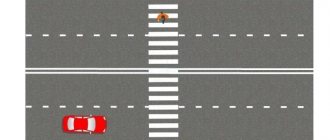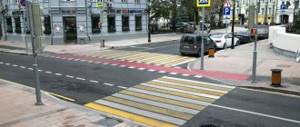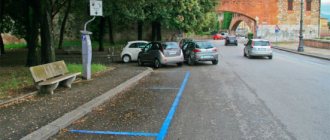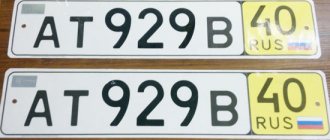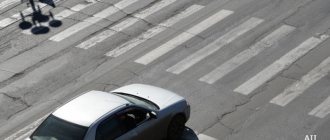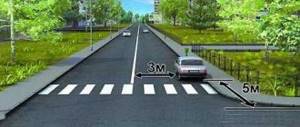Requirements for lighting of a pedestrian overpass: main points
Standards for lighting pedestrian crossings vary depending on the type of terrain, the condition of the road surface, as well as the type of illuminated area (bicycle path, crossing, underground passage). As for the design of lighting for pedestrian crossings specifically in a populated area, it is customary to take as a basis the standards in accordance with GOST R 55706, which may have some additions depending on the type of terrain and the importance of the roadway.
However, the main requirements regarding the quality of the service provided are compliance with the following rules:
- lighting of pedestrian crossings ensures and guarantees recognition of markings and signs;
- in pedestrian areas, facial recognition of passers-by is ensured thanks to high-quality lighting;
- The pedestrian crossing lighting kit is located and installed in such a way as to ensure recognition of the direction of vehicle movement. If necessary, in particularly dangerous areas of the pedestrian zone, several more lighting devices of lower power can be installed;
- an intersection with a place for a pedestrian crossing is marked with self-luminous identification signs at a height of 5 meters from the ground;
- it is recommended to use light sets with a color that is different from the color of the main light source for road lighting;
- in residential neighborhoods, supports (4-9 m) are used with permanent lighting fixtures of the floor lamp installation method, a transition with suspended lighting elements is designed;
- when decorating stairs, lifts, railings, luminous elements are used that will not create a shiny effect for pedestrians and drivers of vehicles;
- the pedestrian crossing designation must be additionally decorated with special “beacon” type lamps at each corner and central islands at a height of 3 m above the roadway. Simultaneous flashing beacons are allowed with a frequency of no more than 60 flashes/min;
- the design of lighting for bicycle paths should be of a different light and lighting intensity than the main road and the crossing;
- decrease in lighting intensity after a pedestrian crossing at least after 10 meters.
Average illumination, according to the light design standards GOST R 55706 at a pedestrian crossing, is not less than 20 (lux). at minimum illumination - at least 6 lux.
Where to go for installation
Unfortunately, today all norms and standards are not fully observed. And if the most comfortable conditions for crossing streets are created for residents of large cities, as well as in the capital, then in provincial settlements there is a serious problem.
Statistics show that in the lion's share of fatal accidents in a metropolis, pedestrians are usually to blame, since they cross the street in the wrong place, while the majority of similar incidents in small towns occur due to the fault of motorists and non-compliance with traffic regulations and road markings.
Difficulties in resolving this issue most often arise due to the ownership of a particular section of the road. Therefore, the action plan should be as follows.
Applying to the district traffic police, where a free-form application is submitted, with a request to install a pedestrian crossing or traffic light on a particular section of the road.
The application must state the whole essence of the issue, always referring to the norms and standards for the arrangement of zebras. Also, photographs of the road section, taking into account the location of the area, must be attached to the application.
The application must be written in your own hand, submitted to the district traffic police department and registered. By law, you must be given a detailed answer within 10 working days.
If the traffic police ignores your request, you can write a complaint to the prosecutor's office about the inaction of the traffic police. A “political” way of organizing traffic is not excluded. You can contact local council deputies with a request to consider this issue.
The issue of road safety is the prerogative of both drivers and pedestrians. However, ridiculous accidents happen as a result of objective reasons, when no one is to blame. Bad weather, incorrect markings, or just a banal coincidence are to blame.
It becomes sad when the only culprit of the incident remains on the sidelines, when it was possible to prevent the tragedy in advance by installing all the necessary structures.
Be careful!
Autonomous lighting of pedestrian crossings: advantages, description, goals
Modern road surfaces are increasingly being designed taking into account the practicality of operating lighting devices, as well as the minimal use of expensive sources of electricity. Thus, lighting of pedestrian crossings using solar eco-batteries is the most popular option.
Read on topic: Geogrid for road construction
Street lights using solar alternative power sources are most often used in areas with long sunny days, since the efficiency of such a lighting device directly depends on the amount of sunlight flow.
Crossings located on the roadway
This category includes checkpoints located on the road itself. Based on the load, they are designed for a smaller number of “visitors”.
According to GOST, the width of the pedestrian crossing on the roadway must correspond to the intensity of human flow: for every estimated five hundred people per hour, one meter is allocated. In this case, the total size should not be less than three meters. In addition, the width of the entire crossing point must be equal to or greater than the width of the sidewalk or pedestrian path that the crossing continues.
To carry out calculations, the following formula is used: B = (Kp /500) x 1(m). In it, Kp is the number of people per hour.
Autonomous lighting: advantage
High-quality lighting of pedestrian crossings will not only help guarantee the safety of pedestrians in the designated place, but will also show all the existing unevenness of the road surface in the designated place, its features and flaws. Autonomous solar-powered lighting works on the principle of storing solar energy during the day and using it up at night.
In areas with short duration of sunny days, the battery charge will be incomplete, this, in turn, reduces the operating time of the flashlights and their intensity at night.
The main advantage of using an alternative source of lighting for a pedestrian crossing of this type is saving energy resources and ensuring an adequate level of safety at night in hard-to-reach, remote areas without a centralized electricity network.
The performance of a solar battery is significantly reduced in conditions of strong wind and dusty weather (field without planting). Energy storage sensors become dirty, and as a result, the accumulated energy is not enough to last all the time.
It is noteworthy that when installing solar lighting devices at a pedestrian crossing, the need for round-the-clock control of turning the devices on and off disappears - the lamp is equipped with special photocells that respond to the intensity of the light flux. The lamp turns on and off itself, which reduces station maintenance costs.
Designing a pedestrian crossing using autonomous lighting stations
Autonomous power plants for the design of a pedestrian crossing are significantly higher in cost than the costs of design from electricity sources. However, this option is considered the most profitable in certain regions of the country. By properly designing the pedestrian overpass area, you can not only control the quality and intensity of lighting, but also significantly reduce the risk of accidents in this area.
Read on topic: Noise stripes on the road
The most commonly used models for lighting pedestrian crossings in populated areas and rural areas are models SEU-1 (with a power of 40-160 W) and SEU-2 (with a power of 180-300 W).
The principle of designing energy-efficient stations at pedestrian crossing points is to comply with all standards and requirements. According to the current GOST. It is worth noting that some features and aspects in the design of the sanctified territory may be slightly adjusted, depending on budgeting.
What it is
A pedestrian crossing is a section of a highway that is intended for pedestrians to cross the roadway and is marked with a road sign of the same name and/or special markings on the roadway itself. Also, this element can be made in the form of an artificially created structure to provide the opportunity for pedestrians to cross to the opposite side of the road without crossing the roadway.
A specialized road sign exists in two versions: a person moves to the left (5.19.1) and to the right (5.19.2).
The basic requirements and rules for the arrangement of pedestrian crossings according to GOST in Russia are recorded in document 32944-2014.
Design of a pedestrian crossing using a stationary source
Providing the right level of lighting at a pedestrian crossing not only reduces the incidence of severe pedestrian fatalities, but also ensures that the road can be crossed safely at the right time. In places where electricity is accessible, pedestrian crossing design options using stationary lighting sources are often used.
In addition to providing lighting elements on the roadway, the law provides for the design of the road area for pedestrians in the form of beacons, self-illuminating elements at zebra crossings, and in difficult areas - an adjustable traffic light with all the necessary signs.
It is worth noting that initially the costs of installing this lighting option are somewhat lower than innovative energy storage options. But during operation, the benefits of using the latter lighting option are noticeable.
Design of lighting for an unregulated pedestrian crossing
Particular attention should be paid to the design of lighting for a pedestrian crossing without a traffic light (unregulated). In this case, sufficient lighting is the key to safety for both the pedestrian and the driver himself.
The design of an uncontrolled crossing for a pedestrian is carried out in the form of installing L-shaped pillars, with lighting support (variable with motion sensors or constant diode).
The site has a pedestrian sign (signboard) and light strips located above the zebra crossing on both sides for the driver of a vehicle. In this case, the green light means the road is free, the red light means a pedestrian is walking. Signs and L-shaped posts are located in four places: on both sides of the pedestrian crossing.
Read on topic: Fuel consumption of UAZ Patriot
The design of pedestrian crossing lighting is a guarantee of safety for all road users, a factor that reduces the risk of fatal accidents.
What is a pedestrian crossing, according to the letter of the law?
Having barely learned to walk, every child begins to hear about the need to cross the road only at the zebra crossing. This humorous name is a type of black and white marking to designate a specialized area for pedestrians to safely cross to the opposite side of the street or road. This area is a pedestrian crossing.
For the first time in this form as we know it, PP arose in Europe in the fifties of the twentieth century. And in the Soviet Union, this technique was adopted a little later - in the sixties.
The choice of black and white (or rather gray and white) colors was not made by chance. Scientists have found that this combination of colors is perceived faster than others by the eye. Although today a lot of experiments are being carried out with other combinations, which is reflected in the innovations of GOST 2014.
According to the standards, pedestrian crossings are installed:
- before intersections;
- close to public transport stops (buses, trams, trolleybuses);
- near schools, hospitals, shopping centers and other heavily visited places.
Depending on the location of the transition, they are of the following types:
- above ground/underground;
- adjustable/unregulated (determined by the presence of a traffic light);
- on the roadway, outside it.
To ensure that such important objects are recognizable to both pedestrians and drivers, the following basic details are used to mark them:
- specialized road markings (aka “zebra”);
- paired pointers.
There are also additional transition symbols:
- signs painted on the asphalt before the start of the zone;
- speed bumps;
- specialized lighting devices along the perimeter of the transition.
